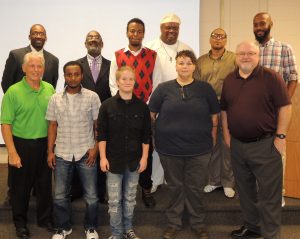
Participants find ‘an opportunity to make a change’
By TIM ROWDEN
Editor
The most recent group of graduates from the BUD (Building Union Diversity) program include a former chef, a former insurance salesmen and medical bill collector, a U.S. Navy veteran and an Ethiopian immigrant among others.
The group of seven graduates – the sixth class since the program started in 2014 – were recognized recently with a graduation ceremony at the AGC Construction Training School in St. Louis.
The next class, a five-week session, starts Sept. 26, but before organizers get there they hope to have 70 percent of this current class indentured into apprenticeship programs and working in the industry.
That shouldn’t be a problem. About 60 people have gone through the program so far and, from those previous classes, 80-to-85 percent of the participants are now enrolled in union apprenticeship programs and have jobs with local contractors.
‘AN OPPORTUNITY TO MAKE A CHANGE’
That’s good news for Amy Generally, a former chef who started working as a cook when she was 16 but decided to get into the building trades after the restaurant she was working for closed.
“I looked at it as an opportunity to make a change,” said Generally, 36. “It’s opened up the door to a new career for me.”
Generally is looking to get into carpentry or heavy equipment operation.
That’s a big change from working as a chef but after completing the BUD program and learning about the building trades, Generally feels she’s up to the challenge of an apprenticeship.
“The work is kind of the same for me,” she said. “I didn’t go to culinary school. I started when I was 16 and I worked for people and I learned and I kind of gained knowledge as I went. That’s kind of how the trades work. You work and you gain knowledge from the people around you and share that knowledge and grow in your field.”
 For Sied Hassan, a 22-year-old immigrant from Ethiopia, the BUD program has provided him with an opportunity to build a real career. He previously worked as a non-union equipment operator, then earned a welding certificate. Now he’s interested in becoming an ironworker.
For Sied Hassan, a 22-year-old immigrant from Ethiopia, the BUD program has provided him with an opportunity to build a real career. He previously worked as a non-union equipment operator, then earned a welding certificate. Now he’s interested in becoming an ironworker.
“This is really a lot to me,” Hassan said. “I’ve been working different places before I came here. I was working as an operating engineer. I got good pay but there were no benefits, so I was just wasting my time.”
Willie Griffin, 47, is a veteran of the U.S. Navy. He’s worked as a machine operator and on a supply ship but most recently has been helping his mother care for his grandmother. Now, the engaged single father is looking to build a career.
“I’ve got to work,” he said. “I’m mostly interested in going into the operating engineers or pipefitting.”
Eric Green, 31, has sold insurance and worked in medical billing since 2009. When he wanted something different, his uncle, a journeyman plasterer told him about BUD and he signed up. “I’m thinking about carpentry. But I’m also interested in becoming an equipment operator or floor laying.”
LANDING A JOB IS KEY
Landing a job is the key, said John Gaal, director of training and workforce development for the St. Louis-Kansas City Carpenters Regional Council in opening remarks at the graduation ceremony.
“We’re not a training program for the sake of training,” Gaal said. “As President Obama has said on more than one occasion, the federal government is going to stop funding these ‘train and pray’ programs. And what he meant by that is that a lot of these programs training people and graduate them and then do not take an active part in their lives in making sure they get work. There’s not a labor leader or a management person in this room who wants to be connected to that type of nonsense.”
 The BUD program was launched in 2014 to bring more minority and female workers into the union trades in a unique partnership of the St. Louis Building & Construction Trades Council, the Eastern Missouri Laborers District Council and St. Louis-Kansas City Regional Carpenters Council, with funding help from the St. Louis Agency on Training and Employment (SLATE) and the Missouri Division of Workforce Development.
The BUD program was launched in 2014 to bring more minority and female workers into the union trades in a unique partnership of the St. Louis Building & Construction Trades Council, the Eastern Missouri Laborers District Council and St. Louis-Kansas City Regional Carpenters Council, with funding help from the St. Louis Agency on Training and Employment (SLATE) and the Missouri Division of Workforce Development.
Participants in the program also receive support from the United Way to help with issues such as car repairs or other problems that may be preventing them from getting or keeping a job.
BUD prepares participants to enter apprenticeships and, with commitment and dedication of their own, begin fulfilling and rewarding careers.
DRIVEN BY NEED
BUD doesn’t only provide an opportunity for participants to get into the trades, it is answering a real need, Gaal said.
When organizers got together to discuss the concept in 2013, the 10-year BJC hospital expansion project and 20-year Metropolitan Sewer District projects were just getting ready to start. Those projects have created a demand for more workers and greater diversity in the workforce.
“We knew – both labor and management and the training programs – that we had to get ahead of the curve and get more people of color and women into the industry,” Gaal said. “We weren’t waiting for the jobs to start. We started this training program considerably ahead of time.”
The trades participating in the program vary from class to class. This latest class included operating engineers, floor layers, plumbers and pipefitters, carpenters, laborers and iron workers.
Union participation is key, Gaal said, because participants get real world training with people who are already in the trades.
“These candidates aren’t sitting in a classroom,” Gaal said. “They’re sitting in million dollar pieces of equipment operating it. That’s the promise that the operating engineers delivered to this BUD program. Who can better teach floor laying than a floor layers? Who can better teach pipefitting than a pipefitter?”
TO PARTICIPATE
People interested in signing up for future BUD classes may contact SLATE at (314) 657-3545.


